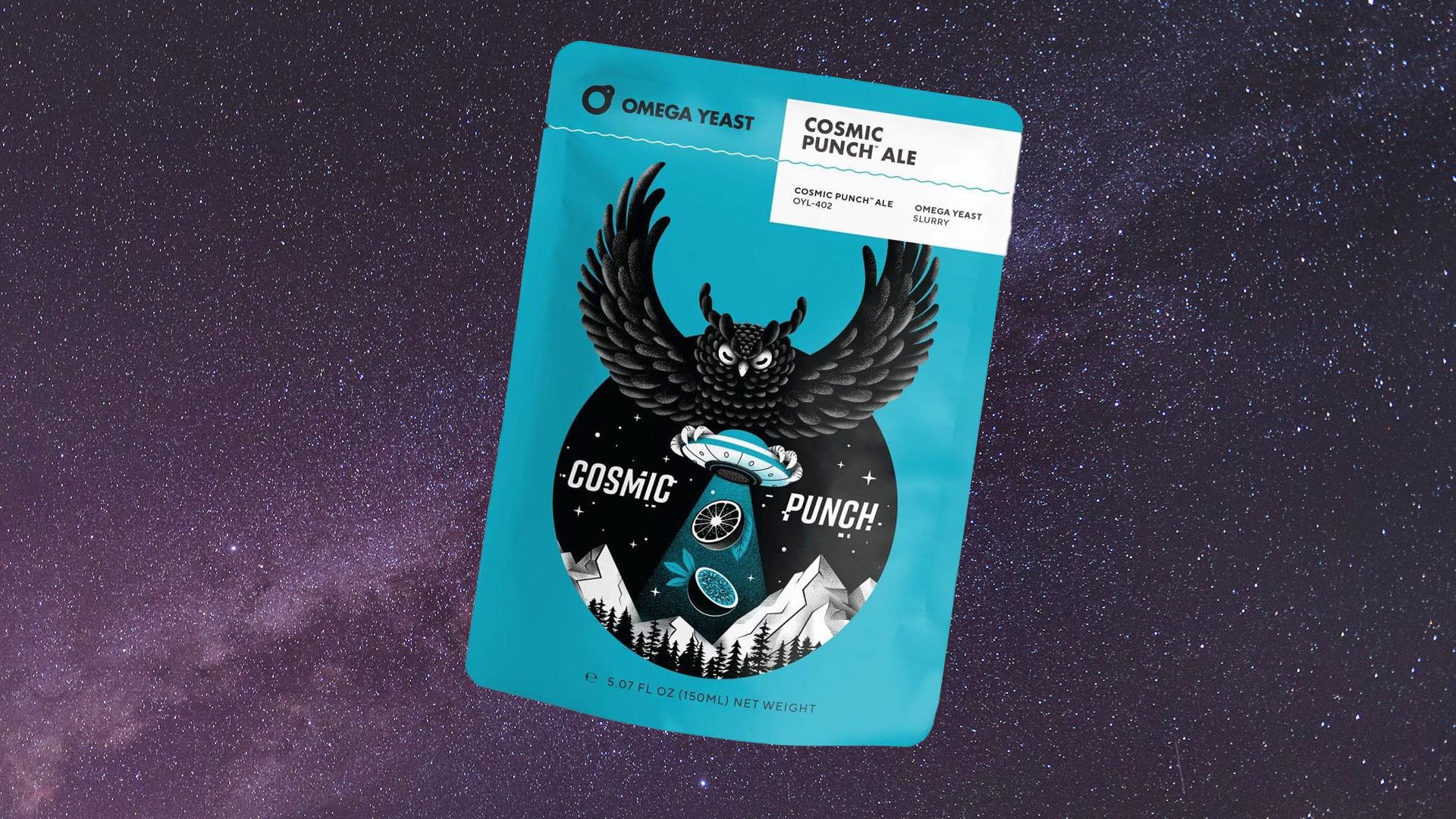
For the last several years, Omega Yeast has been engineering strains of genetically modified yeast—thiolized yeast—to unlock organic compounds in hops and malt called thiols, releasing flavor and aroma.
Thiolized yeast has become hotter than Cold IPAs, provoking white papers, conferences, seminars, and exhaustive research about how unveiling the mystery behind thiols can make your beers juicier and more aromatic.
In particular, Omega Yeast has led the charge, releasing several thiolized yeast strains, including Cosmic Punch, Helio Gazer, Star Party, and Lunar Crush.
By far the most popular, Cosmic Punch is almost like a gateway to thiolized yeast, a great first strain to use if you’re just getting into the game, and quickly becoming an old standby for those wading in deeper.
We sat down with Omega Yeast Director of Research and Development Laura Burns to chat about the flavors Cosmic Punch produces, the feedback from the industry, and the tips and tricks to using this specific strain of thiolized yeast.
(Photography courtesy of Omega Yeast)
Affordable, Industry-Leading Brewery Software
What Is Thiolized Yeast?

Photography courtesy of Omega Yeast
Essentially organic sulfur compounds found in various agricultural products, thiols are naturally existing fragrant elements.
Sometimes, thiols are considered “free,” naturally releasing aromas. However, in other instances, as with hops and malt, thiols are locked away or “bound,” needing an outside factor to unlock their aroma-producing potential.
Thiolized yeast are yeast strains identified as potentially good companions for unlocking aroma-enhancing thiols in beer. To activate these bound/precursor thiols, Omega Yeast genetically modified certain yeast strains.
“What these labs are doing is using this technology for gene editing to modify the DNA of these yeasts to change the way they interact with the substrate they’re in,” New Image Brewing Founder Brandon Capps told Next Glass. “When we say thiolized yeast, what we’re saying is the yeast did not previously have a capability or substantial capability of converting cysteine-amino-acid-bound thiol precursors to free thiols; it now has that ability due to genetic modification where a gene was turned on.”
Consider it similar to flipping a light switch in a dark room (and these Omega Yeast thiolized yeast strains are the finger). “Traditional yeast strains in beer fermentation really struggle to turn on this enzyme at all; it’s not something we normally see in our traditional brewing strains,” says Burns. Meaning that, with a thiolized yeast strain, “now we can express [this enzyme]; it’s active and converting these thiol precursors during fermentation,” says Burns.
“In traditional brewing strains, we just don’t have the opportunity to see this aroma produced,” says Burns. “Yeast metabolism generates those aromas like banana, peach, or sometimes more stone fruit-derived notes, so these thiolized yeast are expanding upon the yeast’s ability to influence flavor and beer.”
With thiolized yeast turning on the proverbial light, brewers can unlock those bound thiols in the beer, releasing them into free thiols and producing these highly aromatic compounds.
Hence: more aromatic beer.
Of course, the unmistakable aromas vary depending on the raw materials used.
The Five Most Common Aromas Thiolized Yeast Imparts on Your Beer

Photography courtesy of Omega Yeast
The exact aromas thiolized yeast can unlock depend on the thiols in different hop varieties.
In this Yakima Valley Hops article, you’ll find a very nice layout of the most common thiols in hops and the aromas associated with them, but here’s a quick guide:
4MMP: black currant and passion fruit
3MH: citrus, rhubarb, exotic fruit
3MHA: passion fruit, guava, tropical fruit
3MO: peaches and stone fruit
3M4MP: rhubarb and citrus
In other words, thiols aren’t adding just any aromas. But ones highly sought after in craft beer.
While the science behind thiolized yeast is still relatively new, a few varieties have reached the mass market. None more popular than Omega Yeast’s Cosmic Punch.
What Is Cosmic Punch Thiolized Yeast?

Graphic courtesy of Omega Yeast
Released over two years ago, Cosmic Punch has been widely used across the industry with much success “because it activates thiols to a level that makes them more apparent but doesn’t become a super thiol bomb,” says Burns. “It’s versatile; people can use a lot in normal hoppy recipes without it being too overwhelming.”
To make Cosmic Punch, Burns says they took the parent strain British V and activated the yeast β‑lyase enzyme—ICR7.
“In normal fermentations in the wort, the yeast won’t express this enzyme,” says Burns. “Basically, there are so many nutrients available for the yeast it doesn’t express this enzyme … because the yeast doesn’t need it; it doesn’t turn on, so in Cosmic Punch, we activated it and turned it on during fermentation.”
According to Burns, with Cosmic Punch, Omega Yeast opened a pathway in one of beer’s favorite brewing yeast strains—London Ale III or what they call British Ale V—to release thiols during fermentation.
Why Does the Industry Love Cosmic Punch?

Photography courtesy of @nibrewing | New Image Brewing
“It’s very new, and brewers are very experimental, so overall, we’ve seen a ton of excitement and interest in using it,” says Burns.
Those like Capps have gone deep down the rabbit hole, perfecting an entire lineup of beers using Cosmic Punch.
New Image’s Phanny Pack series, now in its fifth iteration, leverages Cosmic Punch to produce a super fragrant, perfectly balanced hazy IPA with Southern Cross, Citra, Idaho Gem, and Phantasm.
“Currently, Phanny Pack is, in my opinion, the best beer we’re making with Cosmic Punch,” says Capps. The beer series culminates all Capps’ trials into one now-flagship, year-round series.
With Phanny Pack, “this is a beer that we are brewing with the least batch-to-batch changes in order to really understand the impact of each change,” says Capps, who notes they brewed five different versions before actually settling on what they’re calling the Core. “We modify the Core based on what we’re learning from the other series … but we move more slowly and gradually with Phanny Pack to dial in those changes.”
Capps took time experimenting, reading, and studying to learn the best way to brew with Cosmic Punch because, at the end of the day, it’s “ultimately, how does the beer taste?” says Capps. “We’re producing beer that tastes good … That’s the grain of salt that everyone should have in the back of their mind. You don’t want to make a faster plane if the plane is just crashing.”
Burns notes that Cosmic Punch has become so popular that she’s seen brewers switch entirely from using a house yeast to Cosmic Punch, especially in hoppy styles.
She says one of the reasons is the flavors Cosmic Punch can produce.
What Flavors Does Cosmic Punch Produce?
Cosmic Punch fits the bill for those looking to develop more tropical, guava, and grapefruit aromas.
But what Burns cites as Cosmic Punch’s best feature is that “it’s not a blast-your-face-off-thiol-producing yeast,” she says. “It definitely adds thiol complexity in a more complementary way and doesn’t dominate.”
As sort of a starter thiolized yeast, Cosmic Punch gives brewers an “easy way to augment and put more of a modern hop profile into a beer, emphasizing those more tropical fruity notes,” says Burns.
In contrast, according to Burns, newer strains, such as Helio Gazer, punch up the aroma potential about twenty times that of Cosmic Punch.
And while that can be beneficial, too, “it’s going to be pretty potent, so when you’re putting it into hoppy recipes, it works well, but it can’t go into any recipe in the brewery,” says Burns.
Whereas Cosmic Punch can work well with different beer styles across the board. “We’re trying to provide something that adds complexity and augments the profile of hops people are looking to develop,” says Burns.
Three Tips for Brewing With Cosmic Punch

Photography courtesy of Omega Yeast
Burns says that the first step to brewing with Cosmic Punch is to experiment, seeing how it differs from the original British V strain.
“The biggest application has been to put in traditionally what you develop as a hoppy recipe, especially with Cosmic Punch being a British Ale V lineage; it’s made for juicy-forward styles.”
Next, focus on your hopping rates.
“Cosmic Punch is a way to help saturate flavor but also might allow you to dial back some of those hop additions,” says Burns. “If you’re not getting great yields or getting the benefits out of the extra hops, you can add thiol-releasing yeasts to make that saturation a little bit more sustainable and affordable.”
While Burns says Omega Yeast can provide information on how to build the right recipe if you’re generally looking to amplify and go to the extreme with unlocking thiols, then she suggests using an all-barley grist and mash hopping, where you front-load your mash with hops or other products such as Phantasm.
All help build more precursors into your wort that a thiolized yeast like Cosmic Punch can convert into aromas.
Above all, though, the best advice Burns reiterates when working with Cosmic Punch (or any thiolized yeast) is to test, test, and test again.
“If you’re running a normal brew, strain off a little wort into a separate fermenter … and pitch the Cosmic Punch versus your house strain to see how that aroma changes,” she says. “You can see through variability within your other raw materials that if you don’t have that control, you’re not going to really hone in on what’s different.”
Burns says there are little nuances to any recipe, such as the dry hop dose, the mash hop, etc., that can dramatically change how the yeast reacts. To understand those impacts, you need to “do the control to convince yourself of the aroma impacts you’re seeing,” says Burns.
But if you have the patience, as Capps did, to learn how to leverage Cosmic Punch best, you’ll be rewarded with a beer that’s juicier, more aromatic, and more packed with all those flavors that consumers love.



